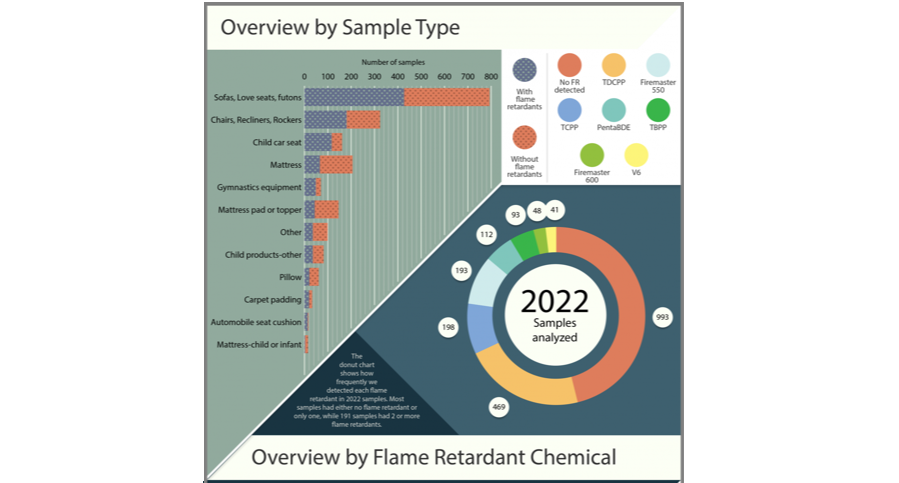
Note in this chart that most flame retardants found by this Duke University study using samples from homes were in child care seats (more than half), then sofas, love seats and futons, with chairs, recliners and rockers coming in at a close second, with about half containing fire retardants. This doesn’t mean the others are safe. There are other toxic chemicals in polyurethane foam. This study measures only fire retardants.
This reader had foam from a memory foam bed in her home through the Foam Project at Duke University.
Any US resident can submit a sample of polyurethane foam (PUF) from furniture, child car seats, or any other product containing PUF using the submission form on our website. After completing the form, samples can be mailed to us at Duke University, along with the unique ID number generated from the submission form. Individuals are notified by email upon receipt of their foam sample in the laboratory. Our laboratory will analyze the sample for the presence or absence of 7 common flame retardant chemicals. Approximately 6-8 weeks later, we will mail back a report detailing our findings, along with a fact sheet about the 7 common flame retardants. We can answer any additional questions you may have after receiving your results.
Hi Debra,
I received results from Duke university where they test peoples foam to see what flame retardants are in it.
My sleep number bed bought about 2010 has FM 550, Firemaster 550. Has brominated and organophosphates.
It said a recent study showed some of the components bioaccumulate and act as a thyroid hormone disrupter.
I have thyroiditis and nodules, and mild hypothyroidism.
I had slept on Coleman air mattresses with PVC vapors prior to sleep number.
I sent them 2 samples, a foam pad beneath the topper and the topper fabric with foam inside.
I have a mattress protector that is waterproof on it made with polyurethane and fabric. Could this block the flame retardant?
Debra’s Answer
I can’t give you a definitive answer about the polyurethane film blocking the fire retardant, but here’s what I can tell you.
The answer to the question is about porosity.
The polyurethane film used for waterproofing has a pore size of 0.03 micrometers to 10 micrometers (a micrometer is one millionth of a meter)
Micro-porous coatings and membranes rely on an interconnected network of tiny holes (pores) introduced by various means into an otherwise impermeable polymeric structure. Sheets of polymers can be produced with common salt incorporated which is washed out afterwards to leave voids/pores. Such holes (or pores) are too small to allow water droplets to pass through, but are large enough to allow water vapour to pass through. Micro-porous structures work, as do tightly woven structures, because of the large difference in size between individual water molecules present in water vapour and water droplets of rain, each of the latter consisting of many millions of water molecules held tightly together by surface tension forces. Micro-porous membranes typically weigh 10–20 g/m2and should be durable and resistant to laundering, chemicals and UV degradation.
SCIENCE DIRECT: Micro Porosity
So the question would be, what is the size of the vapor of the fire retardant? And that’s what I don’t know.
But I think this would be an interesting thing for someone to research.
If we could get a more exact number for the porosity of the polyurethane film and the sizes of various vapors, then we could calculate what types of chemical vapors could be blocked by polyurethane film.



